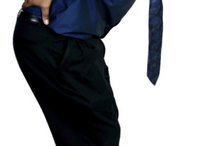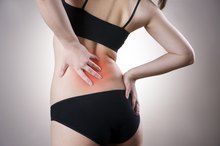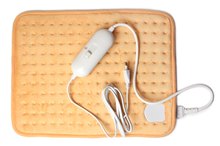Hip & Thigh Pain When Driving
Hip and thigh pain originates from the nerves exiting the spine around the small of the back. These nerves can become inflamed by pressure from bony structures or impingement from soft tissues such as muscles and spinal discs. Driving can aggravate the pain by causing swelling and pressure on the nerves that form the sciatic nerve and other nerves exiting at the level of lower spine.
If you are experiencing serious medical symptoms, seek emergency treatment immediately.
Pain From Bony Structures
The body's joints are protected by cartilage, which prevents the joint's bones from rubbing together, causing pain and inflammation. When the cartilage deteriorates, the nerves become trapped between bones and produces pain. Arthritis is a common cause of this deterioration. When the lower spine or hip joints are affected, it causes pain in the hip and thigh. The National Institute of Health describes arthritis as involving the breakdown of cartilage 1. Cartilage normally protects the joint, allowing for smooth movement. Cartilage also absorbs shock when pressure is placed on the joint.
- The body's joints are protected by cartilage, which prevents the joint's bones from rubbing together, causing pain and inflammation.
- Cartilage normally protects the joint, allowing for smooth movement.
Soft Tissue Nerve Pain
Ischial Bursitis Symptoms
Learn More
Soft tissues such as muscles, tendons and ligaments can become inflamed and cause pressure on nerves. Muscles in the lower back and buttocks can become tight and spasm, causing pressure on the nerves leading to pain in the hip and thigh region. Prolonged stress from driving can cause this tightness, producing pain and discomfort. Frequent rest stops with stretching can help alleviate the discomfort.
- Soft tissues such as muscles, tendons and ligaments can become inflamed and cause pressure on nerves.
- Prolonged stress from driving can cause this tightness, producing pain and discomfort.
Bursitis Pain
Joints of the lower spine and hips have capsules that hold in the lubricating synovial fluid. When these capsules become inflamed, it’s called bursitis. With bursitis, the joints begin to deteriorate from lack of lubrication. According to ThePainClinic.org, inflammation of the superficial and deep bursa produces localized pain over the trochanteric region as well as radiating pain down the outside thigh. Driving can aggravate bursitis by the application of constant pressure on the inflamed bursa. Frequent rest stops with walking can help alleviate this pain.
- Joints of the lower spine and hips have capsules that hold in the lubricating synovial fluid.
- According to ThePainClinic.org, inflammation of the superficial and deep bursa produces localized pain over the trochanteric region as well as radiating pain down the outside thigh.
Hip and Thigh Pain From Discs
Lower Back Arthritis Symptoms
Learn More
Bulging and inflamed spinal discs can result in hip and thigh pain. The Sciatica Clinic reports pain might only come when sitting or standing in a certain position. Clinical experience indicates that these positions are usually associated with continually holding a poor posture either at home or at work. Protruding the head forward peering at a computer all day, regularly lifting a baby out of the back of the car or driving for long periods can aggravate the condition.
- Bulging and inflamed spinal discs can result in hip and thigh pain.
- The Sciatica Clinic reports pain might only come when sitting or standing in a certain position.
Relief
Avoiding hip and thigh pain while driving might be as simple as frequent rest stops with short walks. Adjust the seat for proper posture, making sure there is nothing causing pressure on the buttock area such as a fat wallet. If the pain persist or gets unbearable, consult a doctor for evaluation of your condition.
Related Articles
References
- National Institutes of Health: Arthritis
- Painclinic.com: Joint Pain Hip
- Sciatica Clinic: What is Sciatica? Route of the sciatic nerve down the thigh
- Koh ZSD, Lin S, Hey HWD. Lumbar disc herniation presenting with contralateral symptoms: a case report. J Spine Surg. 2017;3(1):92-94. doi:10.21037/jss.2017.03.06
- Genevay S, Atlas SJ. Lumbar spinal stenosis. Best Pract Res Clin Rheumatol. 2010;24(2):253-65. doi:10.1016/j.berh.2009.11.001
- Sherry M. Examination and treatment of hamstring related injuries. Sports Health. 2012;4(2):107-14. doi:10.1177/1941738111430197
- Lavine R. Iliotibial band friction syndrome. Curr Rev Musculoskelet Med. 2010;3(1-4):18-22. doi:10.1007/s12178-010-9061-8
- Ryan AS, Buscemi A, Forrester L, Hafer-macko CE, Ivey FM. Atrophy and intramuscular fat in specific muscles of the thigh: associated weakness and hyperinsulinemia in stroke survivors. Neurorehabil Neural Repair. 2011;25(9):865-72. doi:10.1177/1545968311408920
- Centers for Disease Control and Prevention. Understanding Blood Clots. Updated March 14, 2019.
- Cherkin DC, Sherman KJ, Avins AL, et al. A randomized trial comparing acupuncture, simulated acupuncture, and usual care for chronic low back pain. Arch Intern Med. 2009;169(9):858-66. doi:10.1001/archinternmed.2009.65
- Lempainen L. Operative treatment for the painful posterior thigh after hamstring autograft harvesting. Muscles, Ligaments and Tendons Journal. 2017;7(3):570. doi:10.11138/mltj/2017.7.3.570
Writer Bio
Mark Little began his professional writing career in 2009 with his work appearing on various websites. He emphasizes alternative approaches to health-related issues. He is certified as a sports nutritionist by the International Fitness Association. Little graduated from Texas Chiropractic College with a Doctor of Chiropractic degree.









